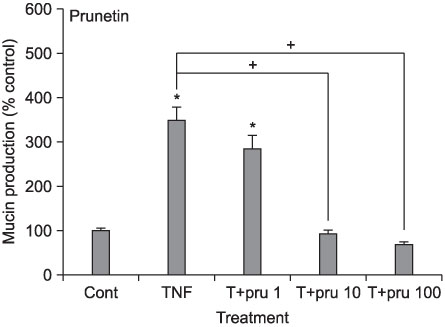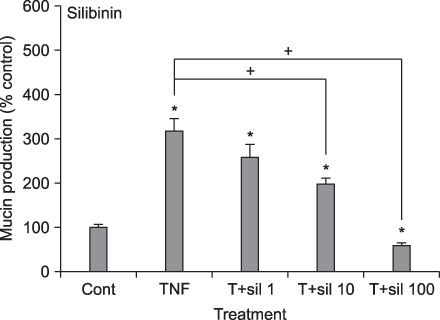Tuberc Respir Dis.
2010 Nov;69(5):348-353.
Regulation of Tumor Necrosis Factor-alpha-induced Airway Mucin Production and Gene Expression by Carbenoxolone, Prunetin, and Silibinin
- Affiliations
-
- 1Department of Pharmacology, Chungnam National University School of Medicine, Daejeon, Korea. LCJ123@cnu.ac.kr
- 2Department of Radiologic Technology, Daegu Health College, Daegu, Korea.
- 3LG Life Science, Seoul, Korea.
- 4Pulmonology Section, Department of Internal Medicine, Chungnam National University Hospital, Chungnam National University School of Medicine, Daejeon, Korea.
Abstract
- BACKGROUND
In this study, we tried to investigate whether carbenoxolone, prunetin, and silibinin affect tumor necrosis factor (TNF)-alpha-induced MUC5AC mucin production and gene expression from human airway epithelial cells.
METHODS
Confluent NCI-H292 cells were pretreated with each agent (carbenoxolone, prunetin, and silibinin) for 30 min and then stimulated with TNF-alpha for 24 hours. The MUC5AC mucin gene expression and mucin protein production were measured by reverse transcription-polymerase chain reaction and enzyme linked immunosorbent assay, respectively.
RESULTS
Carbenoxolone, prunetin and silibinin inhibited the production of MUC5AC mucin protein induced by TNF-alpha; the 3 compounds also inhibited the expression of MUC5AC mucin gene induced by TNF-alpha.
CONCLUSION
This result suggests that carbenoxolone, prunetin and silibinin can inhibit mucin gene expression and production of mucin protein induced by TNF-alpha, by directly acting on airway epithelial cells.
Keyword
MeSH Terms
Figure
Reference
-
1. Voynow JA, Rubin BK. Mucins, mucus, and sputum. Chest. 2009. 135:505–512.2. Lee CJ, Lee JH, Seok JH, Hur GM, Park YC, Seol IC, et al. Effects of baicalein, berberine, curcumin and hesperidin on mucin release from airway goblet cells. Planta Med. 2003. 69:523–526.3. Heo HJ, Lee SY, Lee MN, Lee HJ, Seok JH, Lee CJ. Genistein and curcumin suppress epidermal growth factor-induced MUC5AC mucin production and gene expression from human airway epithelial cells. Phytother Res. 2009. 23:1458–1461.4. Research Institute of Natural Products, Seoul National University. Treatise on Asian herbal medicines. 2003. Seoul: Haksulpyeonsugwan.5. Tanaka Y, Kikuzaki H, Fukuda S, Nakatani N. Antibacterial compounds of licorice against upper airway respiratory tract pathogens. J Nutr Sci Vitaminol (Tokyo). 2001. 47:270–273.6. Suzuki S, Koyama K, Darnel A, Ishibashi H, Kobayashi S, Kubo H, et al. Dexamethasone upregulates 11beta-hydroxysteroid dehydrogenase type 2 in BEAS-2B cells. Am J Respir Crit Care Med. 2003. 167:1244–1249.7. Suzuki S, Matsuda Y, Sugawara T, Tabata T, Ishibashi H, Hoshikawa Y, et al. Effects of carbenoxolone on alveolar fluid clearance and lung inflammation in the rat. Crit Care Med. 2004. 32:1910–1915.8. Asl MN, Hosseinzadeh H. Review of pharmacological effects of Glycyrrhiza sp. and its bioactive compounds. Phytother Res. 2008. 22:709–724.9. Jung HA, Kim AR, Chung HY, Choi JS. In vitro antioxidant activity of some selected Prunus species in Korea. Arch Pharm Res. 2002. 25:865–872.10. Ko WC, Shih CM, Lai YH, Chen JH, Huang HL. Inhibitory effects of flavonoids on phosphodiesterase isozymes from guinea pig and their structure-activity relationships. Biochem Pharmacol. 2004. 68:2087–2094.11. Sheikh S, Weiner H. Allosteric inhibition of human liver aldehyde dehydrogenase by the isoflavone prunetin. Biochem Pharmacol. 1997. 53:471–478.12. Keung WM. Biochemical studies of a new class of alcohol dehydrogenase inhibitors from Radix puerariae. Alcohol Clin Exp Res. 1993. 17:1254–1260.13. Polyak SJ, Morishima C, Lohmann V, Pal S, Lee DY, Liu Y, et al. Identification of hepatoprotective flavonolignans from silymarin. Proc Natl Acad Sci U S A. 2010. 107:5995–5999.14. Trappoliere M, Caligiuri A, Schmid M, Bertolani C, Failli P, Vizzutti F, et al. Silybin, a component of sylimarin, exerts anti-inflammatory and anti-fibrogenic effects on human hepatic stellate cells. J Hepatol. 2009. 50:1102–1111.15. Singh RP, Raina K, Sharma G, Agarwal R. Silibinin inhibits established prostate tumor growth, progression, invasion, and metastasis and suppresses tumor angiogenesis and epithelial-mesenchymal transition in transgenic adenocarcinoma of the mouse prostate model mice. Clin Cancer Res. 2008. 14:7773–7780.16. Li L, Gao Y, Zhang L, Zeng J, He D, Sun Y. Silibinin inhibits cell growth and induces apoptosis by caspase activation, down-regulating survivin and blocking EGFR-ERK activation in renal cell carcinoma. Cancer Lett. 2008. 272:61–69.17. Ligeret H, Brault A, Vallerand D, Haddad Y, Haddad PS. Antioxidant and mitochondrial protective effects of silibinin in cold preservation-warm reperfusion liver injury. J Ethnopharmacol. 2008. 115:507–514.18. Hogan FS, Krishnegowda NK, Mikhailova M, Kahlenberg MS. Flavonoid, silibinin, inhibits proliferation and promotes cell-cycle arrest of human colon cancer. J Surg Res. 2007. 143:58–65.19. Lee SO, Jeong YJ, Im HG, Kim CH, Chang YC, Lee IS. Silibinin suppresses PMA-induced MMP-9 expression by blocking the AP-1 activation via MAPK signaling pathways in MCF-7 human breast carcinoma cells. Biochem Biophys Res Commun. 2007. 354:165–171.20. Rogers DF, Barnes PJ. Treatment of airway mucus hypersecretion. Ann Med. 2006. 38:116–125.21. Fischer BM, Rochelle LG, Voynow JA, Akley NJ, Adler KB. Tumor necrosis factor-alpha stimulates mucin secretion and cyclic GMP production by guinea pig tracheal epithelial cells in vitro. Am J Respir Cell Mol Biol. 1999. 20:413–422.22. Shao MX, Ueki IF, Nadel JA. Tumor necrosis factor alpha-converting enzyme mediates MUC5AC mucin expression in cultured human airway epithelial cells. Proc Natl Acad Sci U S A. 2003. 100:11618–11623.23. Song KS, Lee WJ, Chung KC, Koo JS, Yang EJ, Choi JY, et al. Interleukin-1 beta and tumor necrosis factor-alpha induce MUC5AC overexpression through a mechanism involving ERK/p38 mitogen-activated protein kinases-MSK1-CREB activation in human airway epithelial cells. J Biol Chem. 2003. 278:23243–23250.24. Chung KF. Cytokines in chronic obstructive pulmonary disease. Eur Respir J Suppl. 2001. 34:50s–59s.25. Cohn L, Whittaker L, Niu N, Homer RJ. Cytokine regulation of mucus production in a model of allergic asthma. Novartis Found Symp. 2002. 248:201–213.26. Takeyama K, Dabbagh K, Lee HM, Agustí C, Lausier JA, Ueki IF, et al. Epidermal growth factor system regulates mucin production in airways. Proc Natl Acad Sci U S A. 1999. 96:3081–3086.
- Full Text Links
- Actions
-
Cited
- CITED
-
- Close
- Share
- Similar articles
-
- Effect of Prunetin on TNF-alpha-Induced MUC5AC Mucin Gene Expression, Production, Degradation of IkappaB and Translocation of NF-kappaB p65 in Human Airway Epithelial Cells
- Effects of Cynaroside, Cynarin and Linarin on Secretion, Production and Gene Expression of Airway MUC5AC Mucin in NCI-H292 Cells
- Apigenin Inhibits Tumor Necrosis Factor-alpha-Induced Production and Gene Expression of Mucin through Regulating Nuclear Factor-Kappa B Signaling Pathway in Airway Epithelial Cells
- Effects of Lupenone, Lupeol, and Taraxerol Derived from Adenophora triphylla on the Gene Expression and Production of Airway MUC5AC Mucin
- Effects of Curcumin and Genistein on Phorbol Ester or Tumor Necrosis Factor-alpha-Induced Mucin Production from Human Airway Epithelial Cells





